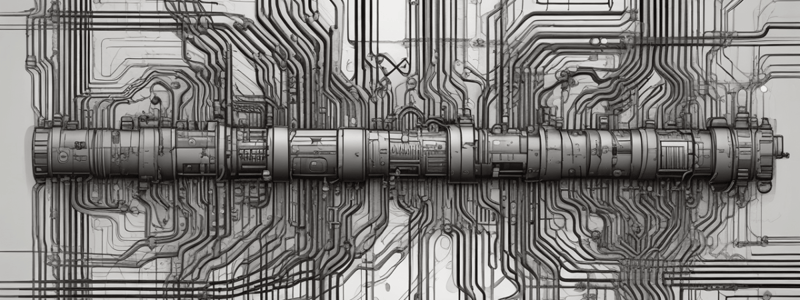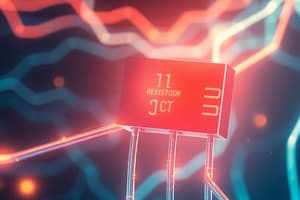Podcast
Questions and Answers
What is the primary role of a resistor in an electric circuit?
What is the primary role of a resistor in an electric circuit?
- To increase the flow of charge
- To store energy in the circuit
- To resist the flow of charge (correct)
- To provide a complete loop for electrons
How is resistance mathematically defined?
How is resistance mathematically defined?
- Voltage divided by current (correct)
- Voltage multiplied by current
- Current divided by voltage
- Current multiplied by voltage
What does an ammeter measure in a circuit?
What does an ammeter measure in a circuit?
- Power consumed by the bulbs
- Resistance of the circuit
- Flow of charge in amps (correct)
- Voltage across a resistor
When a second bulb is added to the circuit, how does it affect current?
When a second bulb is added to the circuit, how does it affect current?
Which of the following components is essential for completing an electric circuit?
Which of the following components is essential for completing an electric circuit?
What occurs when three bulbs are connected in series within a circuit?
What occurs when three bulbs are connected in series within a circuit?
In the context of the lab steps, what is the first action to be taken?
In the context of the lab steps, what is the first action to be taken?
What analogy is used to describe the flow of electricity in a circuit?
What analogy is used to describe the flow of electricity in a circuit?
What happens to the voltage when additional bulbs are added in series to a circuit?
What happens to the voltage when additional bulbs are added in series to a circuit?
Why is it important to note down the readings on the ammeter after each step?
Why is it important to note down the readings on the ammeter after each step?
What effect does adding resistors in series have on the overall resistance of a circuit?
What effect does adding resistors in series have on the overall resistance of a circuit?
In this lab setup, what do the bulbs represent within the circuit?
In this lab setup, what do the bulbs represent within the circuit?
What is the purpose of using an ammeter in the described physics lab?
What is the purpose of using an ammeter in the described physics lab?
How is the relationship between current, voltage, and resistance expressed in this lab?
How is the relationship between current, voltage, and resistance expressed in this lab?
What happens to the current reading on the ammeter when a second bulb is added to the circuit in series?
What happens to the current reading on the ammeter when a second bulb is added to the circuit in series?
Why is it necessary to create a complete loop in the electric circuit?
Why is it necessary to create a complete loop in the electric circuit?
In the lab, if the voltage of the battery is kept constant and more bulbs are added, what is likely to happen to the total current?
In the lab, if the voltage of the battery is kept constant and more bulbs are added, what is likely to happen to the total current?
What can be inferred if the ammeter shows zero current during the experiment?
What can be inferred if the ammeter shows zero current during the experiment?
If the first bulb had a resistance of 10 ohms and the battery voltage was 20 volts, what was the current in that circuit?
If the first bulb had a resistance of 10 ohms and the battery voltage was 20 volts, what was the current in that circuit?
What is the primary purpose of documenting the readings on the ammeter after each step in the lab?
What is the primary purpose of documenting the readings on the ammeter after each step in the lab?
Flashcards are hidden until you start studying
Study Notes
Understanding Resistors
- A resistor is a circuit component that opposes the flow of electric charge.
- Resistors convert electrical energy into other forms, effectively reducing the available energy for other components in the circuit.
Electric Circuits Overview
- An electric circuit consists of a complete loop allowing electrons to flow from a voltage or current source, similar to water flowing in a water slide.
- Current, measured in amps, indicates the rate of charge flow through the circuit.
Physics Lab Procedure
- Required materials:
- Battery
- Three small bulbs
- Five wires
- Ammeter (to measure current)
- Steps for experiment:
- Connect the battery, ammeter, and one bulb in series to complete the circuit.
- Record the ammeter reading and battery voltage.
- Add a second bulb into the circuit and note the new current reading.
- Add a third bulb and again note the current measurement.
- Data should be organized in a table format.
Data Analysis
- Initial circuit with one bulb provides a specific current value and battery voltage.
- Resistance is calculated as voltage divided by current (R = V/I).
- With two bulbs, the current typically reduces to half, indicating that total resistance doubled while battery voltage remains constant.
- Adding a third bulb further decreases current to a third of the initial value, resulting in three times the original resistance.
- Conclusion: Increasing the number of resistors in a circuit decreases the current flow, illustrating the inverse relationship between resistance and current.
Understanding Resistors
- A resistor is a circuit component that opposes the flow of electric charge.
- Resistors convert electrical energy into other forms, effectively reducing the available energy for other components in the circuit.
Electric Circuits Overview
- An electric circuit consists of a complete loop allowing electrons to flow from a voltage or current source, similar to water flowing in a water slide.
- Current, measured in amps, indicates the rate of charge flow through the circuit.
Physics Lab Procedure
- Required materials:
- Battery
- Three small bulbs
- Five wires
- Ammeter (to measure current)
- Steps for experiment:
- Connect the battery, ammeter, and one bulb in series to complete the circuit.
- Record the ammeter reading and battery voltage.
- Add a second bulb into the circuit and note the new current reading.
- Add a third bulb and again note the current measurement.
- Data should be organized in a table format.
Data Analysis
- Initial circuit with one bulb provides a specific current value and battery voltage.
- Resistance is calculated as voltage divided by current (R = V/I).
- With two bulbs, the current typically reduces to half, indicating that total resistance doubled while battery voltage remains constant.
- Adding a third bulb further decreases current to a third of the initial value, resulting in three times the original resistance.
- Conclusion: Increasing the number of resistors in a circuit decreases the current flow, illustrating the inverse relationship between resistance and current.
Studying That Suits You
Use AI to generate personalized quizzes and flashcards to suit your learning preferences.




